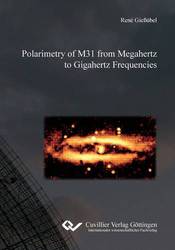| Departments | |
|---|---|
| Book Series (96) |
1378
|
| Nachhaltigkeit |
3
|
| Gesundheitswesen |
1
|
| Humanities |
2364
|
| Natural Sciences |
5406
|
| Mathematics | 229 |
| Informatics | 319 |
| Physics | 980 |
| Chemistry | 1363 |
| Geosciences | 131 |
| Human medicine | 243 |
| Stomatology | 10 |
| Veterinary medicine | 108 |
| Pharmacy | 147 |
| Biology | 835 |
| Biochemistry, molecular biology, gene technology | 121 |
| Biophysics | 25 |
| Domestic and nutritional science | 45 |
| Agricultural science | 1004 |
| Forest science | 201 |
| Horticultural science | 20 |
| Environmental research, ecology and landscape conservation | 148 |
| Engineering |
1793
|
| Common |
98
|
|
Leitlinien Unfallchirurgie
5. Auflage bestellen |
|
Advanced Search
Polarimetry of M31 from Megahertz to Gigahertz Frequencies (English shop)
René Gießübel (Author)Preview
Table of Contents, PDF (49 KB)
Extract, PDF (320 KB)
M31, better known as the Andromeda Galaxy, is the nearest grand spiral galaxy. Its proximity allows us to reach high spatial resolutions and study it in great detail. Already early analysis of the polarized emission has shown that the turbulent and large-scale magnetic field is concentrated in a ring-like structure at 10 kpc radius. The presence of a regular field over such long distances can be explained by galactic dynamo theory. However, the structure of the M31’s large-scale magnetic field is unusually simple. An almost purely axisymmetric field is not known from any other spiral galaxy.
The aim of this work is to provide new clues to the understanding of M31’s magnetic field structure, by utilizing new methods for data analysis, better resolutions and higher sensitivities than ever before, and by advancing into new wavelength regimes.
| ISBN-13 (Hard Copy) | 9783954043088 |
| ISBN-13 (eBook) | 9783736943087 |
| Final Book Format | A5 |
| Language | English |
| Page Number | 144 |
| Lamination of Cover | matt |
| Edition | 1. |
| Publication Place | Göttingen |
| Place of Dissertation | Köln |
| Publication Date | 2012-12-17 |
| General Categorization | Dissertation |
| Departments |
Physics
|
| Keywords | galaxies, galactic magnetic fields, M31, radio continuum, polarization |








